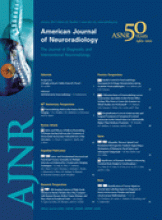Research ArticleResearch Perspectives
Open Access
MR Imaging Features of High-Grade Gliomas in Murine Models: How They Compare with Human Disease, Reflect Tumor Biology, and Play a Role in Preclinical Trials
A.R. Borges, P. Lopez-Larrubia, J.B. Marques and S.G. Cerdan
American Journal of Neuroradiology January 2012, 33 (1) 24-36; DOI: https://doi.org/10.3174/ajnr.A2959
A.R. Borges
P. Lopez-Larrubia
J.B. Marques

References
- 1.↵
- 2.↵
- Gutmann DH,
- Hunter-Schaedle K,
- Shannon KM
- 3.↵
- Fomchenko EI,
- Holland EC
- 4.↵
- Miura FK,
- Alves MJ,
- Rocha MC,
- et al
- 5.↵
- Taillandier L,
- Antunes L,
- Angioi-Duprez K.S.
- 6.↵
- 7.↵
- Holland EC
- 8.↵
- Weiss WA,
- Israel M,
- Cobbs C,
- et al
- 9.↵
- 10.↵
- Aldape K,
- Colman H,
- James C
- 11.↵
- Smilowitz HM,
- Weissenberger J,
- Weis J,
- et al
- 12.↵
- Huse JT,
- Holland EC
- 13.↵
- Marumoto T,
- Tashiro A,
- Friedmann-Morvinski D,
- et al
- 14.↵
- 15.↵
- Lyons SK
- 16.↵
- Nieman BJ,
- Bock NA,
- Bishop J,
- et al
- 17.↵
- Lal S,
- Lacroix M,
- Tofilon P,
- et al
- 18.↵
- Collier LS,
- Adams DJ,
- Hackett CS,
- et al
- 19.↵
- de Groot JF,
- Fuller G,
- Kumar AJ,
- et al
- 20.↵
- Radaelli E,
- Ceruti R,
- Patton V,
- et al
- 21.↵
- Johnson GA,
- Cofer GP,
- Gewalt SL,
- et al
- 22.↵
- Dazai J,
- Bock NA,
- Nieman BJ,
- et al
- 23.↵
- Righi V,
- Roda JM,
- Paz J,
- et al
- 24.↵
- Jost SC,
- Wanebo JE,
- Song SK,
- et al
- 25.↵
- Radaelli E,
- Ceruti R,
- Patton V,
- et al
- 26.↵
- 27.↵
- 28.↵
- Kemper EM,
- Leenders W,
- Küsters B,
- et al
- 29.↵
- 30.↵
- Rehemtulla A,
- Stegman LD,
- Cardozo SJ,
- et al
- 31.↵
- Szentirmai O,
- Baker CH,
- Lin N,
- et al
- 32.↵
- 33.↵
- 34.↵
- 35.↵
- 36.↵
- Sun Y,
- Schmidt NO,
- Schmidt K,
- et al
- 37.↵
- Veeravagu A,
- Hou LC,
- Hsu AR,
- et al
- 38.↵
- Cha S,
- Johnson G,
- Wadghiri YZ,
- et al
- 39.↵
- Gossmann A,
- Helbich TH,
- Kuriyama N,
- et al
- 40.↵
- Muir ER,
- Shen Q,
- Duong TQ
- 41.↵
- Wong ET,
- Brem S
- 42.↵
- Nagaraja TN,
- Ewing JR,
- Karki K,
- et al
- 43.↵
- Sipkins DA,
- Cheresh DA,
- Kazemi MR
- 44.↵
- 45.↵
- Chenevert TL,
- Stegman LD,
- Taylor JM,
- et al
- 46.↵
- 47.↵
- Fan G,
- Zang P,
- Jing F,
- et al
- 48.↵
- 49.↵
- Yetkin FZ,
- Mendelsohn D
- 50.↵
- de Vries NA,
- Beijnen JH,
- van Tellingen O
- 51.↵
- 52.↵
- Moffat BA,
- Chen M,
- Kariaapper MS,
- et al
- 53.↵
- Mathieu V,
- De Nève N,
- Le Mercier M,
- et al
- 54.↵
- McConville P,
- Hambardzumyan D,
- Moody JB
- 55.↵
- 56.↵
- 57.↵
- Heckl S,
- Pipkorn R,
- Nägele T,
- et al
- 58.↵
- de Backer ME,
- Nabuurs RJ,
- van Buchem MA,
- et al
- 59.↵
- 60.↵
- Chirasani SR,
- Markovic DS,
- Synowitz M,
- et al
- 61.↵
- Saxena V,
- Gonzalez-Gomez I,
- Laug WE
- 62.↵
In this issue
Advertisement
A.R. Borges, P. Lopez-Larrubia, J.B. Marques, S.G. Cerdan
MR Imaging Features of High-Grade Gliomas in Murine Models: How They Compare with Human Disease, Reflect Tumor Biology, and Play a Role in Preclinical Trials
American Journal of Neuroradiology Jan 2012, 33 (1) 24-36; DOI: 10.3174/ajnr.A2959
0 Responses
Jump to section
Related Articles
- No related articles found.
Cited By...
- No citing articles found.
This article has not yet been cited by articles in journals that are participating in Crossref Cited-by Linking.
More in this TOC Section
Similar Articles
Advertisement











